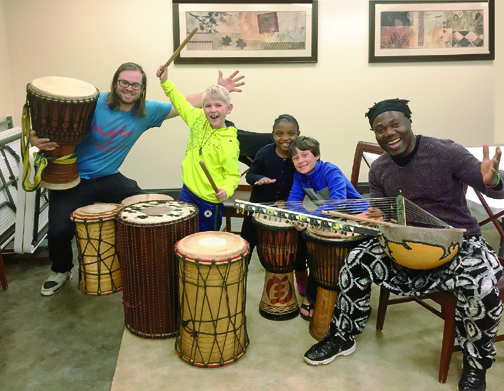
by Mark Smiley | Jun 23, 2017 | Feature Story Bottom Left
by Mark Smiley
 The Glendale Sports Center is best known for its sports, fitness, and teen programs. Many are unaware it offers music lessons as well. The arts and humanities division of the Glendale Sports Center currently offers private piano, drum, and guitar lessons. Lessons are $36 each hour and sold in groups of four.
The Glendale Sports Center is best known for its sports, fitness, and teen programs. Many are unaware it offers music lessons as well. The arts and humanities division of the Glendale Sports Center currently offers private piano, drum, and guitar lessons. Lessons are $36 each hour and sold in groups of four.
Music lessons are open to the public so one does not need to be a member of the center. Group lessons are offered at a discount if you have membership. Instruments are provided so participants do not need to bring their own.
Lessons are one hour. Lessons are open to all ages. Alex Tripp (piano), Kevin Lee (guitar), and John Olson (drums) are the instructors who are lined up to teach participants. “With music no longer offered in schools, the Sports Center has been a great resource to ensure my son is getting this fundamental curriculum,” said Kristal Steeves, parent of a participant.
Emily Andrews, Program Coordinator for the Glendale Sports Center has been with the Center for almost a year and is committed to building the programs. “Our instructors are phenomenal,” said Andrews. “We are very lucky to have such a dedicated and committed team to offer these great programs.”
Private pickleball and tennis lessons are also available. These lessons can be either 30 minute or 60 minute. Prices vary so call the Glendale Sports Center for more details.
To sign up for a lesson, visit www.sportscenterglendale.com or call 303-639-4711.

by Mark Smiley | Jun 23, 2017 | General Featured
DPS Board Votes Unanimously In Reynolds’ Favor
by Ruthy Wexler
 In an extraordinary reversal of fortune, The Denver Public Schools Board of Education at its meeting on June 19, 2017, chose existing Greenlee Elementary School Principal Sheldon Reynolds to lead the restart of Greenlee in 2018-19. He will keep his staff for this next school year and for the upcoming restart, which will be under a new name, Center for Talent Development at Greenlee (CTD).
In an extraordinary reversal of fortune, The Denver Public Schools Board of Education at its meeting on June 19, 2017, chose existing Greenlee Elementary School Principal Sheldon Reynolds to lead the restart of Greenlee in 2018-19. He will keep his staff for this next school year and for the upcoming restart, which will be under a new name, Center for Talent Development at Greenlee (CTD).
If Reynolds hadn’t been chosen to lead the restart, he would still be acting principal of Greenlee in the 2017-18 school year, but it would have been a year filled with sadness, teacher unrest, staff seeking employment at other schools — and his own disappointment at not being able to continue the work he had begun.
The Board had designated Greenlee as “persistently low-performing,” along with another elementary Denver school in December 2016 (still another elementary school, Gilpin Montessori, was closed for good due to failure of test scores to improve sufficiently. Under the recently adopted School Performance Compact (SPC) subjective factors are eliminated and a purported objective mandate based on primarily test scores control. See Greenlee Elementary On The Chopping Block, front page Glendale Cherry Creek Chronicle, March 2017.
The outcry from the parents, students, teachers and others involved with the school, which is located at 1150 Lipan Street, was immediate. In the first 18 months of Reynolds’ tenure at Greenlee morale and test scores had soared but simply just not enough under the criteria set out in the SPC. Greenlee faces a plethora of challenges including the fact that it is a school with a majority of low income students for whom English is a second language.
The competition for the restart was opened to any school providers who wanted to submit a “high quality” plan, according to DPS’s requirements.
Reynolds made a presentation along with a half dozen other applicants at the School Board meeting on May 11. After the June 19 Board vote the only real change in Greenlee Elementary will be its name,
which will now be Center for Talent and Development at Greenlee and that is just fine with the community surrounding the school which had come to embrace Reynolds and his reform efforts.
Reading teacher Lisa Friedman whooped with joy at the news. “Now we can continue the work we started. I can’t wait.”
“It’s been an interesting journey, hasn’t it?” a smiling Anne Rowe, President of the Denver School Board, said to Reynolds at a June 12 Board meeting, a week before the Board’s final vote. (This June 12 meeting’s purpose was for a newly instituted Community Review Board to recommend a school to lead Greenlee’s restart; they unanimously chose Reynolds’ plan and Reynolds’ leadership.)
“Yes,” Reynolds agreed — his tone not quite as lighthearted as Rowe’s.
Changing A School
“When I first stepped into Greenlee, I knew nothing about the SPC,” said Reynolds. “Honestly, if I had known, I never would have taken the job.”
In 2015 Reynolds was offered two Denver schools and chose Greenlee. He welcomed the opportunity to turn an unpromising school around. The way he’d do it was with a “talent development model,” a concept he’d studied while working on his doctorate in educational leadership. The North Carolina school he built entirely on that model in 2010 not only won awards, it changed the area’s demographics, when families moved nearby to enroll their kids.
Reynolds had just laid the groundwork for change at Greenlee — knowing it could take up to five years to completely change a school — when he had to shift gears for the restart plan.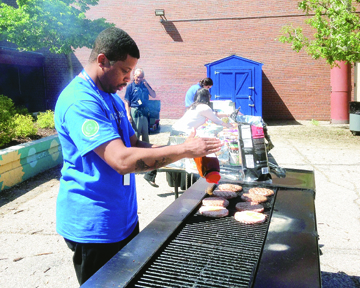
No Room For Error
The restart competition got kicked off with DPS’s Call for New Quality Schools (The Call), which invited “school developers” to submit “high quality designs” for the two schools to be restarted as well as proposals for new schools. Reynolds knew his basic design; he’d given it a new name (CTD). The hard part would be having his vision shine through while addressing every detailed requirement listed in The Call.
Comfortable with tapping the strengths of those around him, Reynolds met continually with staff, who, he said, “pushed me to define what makes our school different.”
Detecting a “woe is me, the District is out to get us” mentality, Reynolds coached his teachers toward this attitude: “We control what happens.”
“I told them, ‘People might not see you, but I know you guys are great teachers.’ See, I already had that turnaround mentality, you’ve got to be better than a teacher at another school, better than another principal … There’s no room for error when you’re turning a school around.”
Working together produced unity. At the Special Board of Education meeting on May 11, when applicants formally presented their plans, a dozen teachers surrounded Reynolds, all wearing resolute expressions and bright blue Greenlee sweatshirts.
At the beginning of that meeting, Greenlee parents pleaded to keep their principal. One young mother said tremulously, “My grandmother, who just passed away, worked at Greenlee for 26 years. She saw principals come and go. When Mr. Reynolds arrived, she knew he was the one we needed…”
Only one school emerged to challenge Reynolds for Greenlee’s restart: Wyoming-based Poder Academy. CEO Marco Martinez said he needed to take the school over because Greenlee, “despite infusions of help, has been drastically underperforming,” assuring the Board that with strict behavioral expectations, he would “turn the school and community around.”
The Work We Started
Martinez’s words — and DPS’s description of Greenlee as “persistently low-performing” — seemed to belong to a different world than the one inhabited by Greenlee teachers and parents.
When his turn arrived, Reynolds tied the two worlds together. “One thing I want to spell out clearly: if you don’t know us, it’s easy to say our students are broken, our teachers are broken, our community is broken. But once you work in our community, you see how strong it is …”
Asked by the Board what his new plan would change, Reynolds was hard put to give a specific answer. He’d added elements, notably a “birth to 5th” program to include very young children. But the basic concepts he ran the school on would remain.
On June 12, Reynolds spoke frankly to the Board, allowing that the restart process had pushed him to articulate “what makes our school unique. That’s where I wanted to end up … it’s just not how I wanted to get here.”
Having to draw so hard on his and staff’s resources drove him to be “an architect” for deeply held beliefs. “In the process, I bonded with my community. I put my name on it.”
And while others wish summer vacation could last longer, the staff, students and parents at Greenlee can’t wait for the new school year to begin.
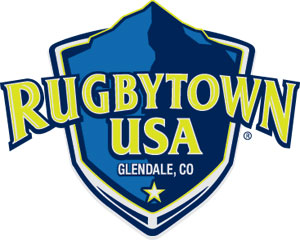
by Mark Smiley | Jun 23, 2017 | Glendale City News
by Kurt Woock
Writer for and on behalf of the City of Glendale
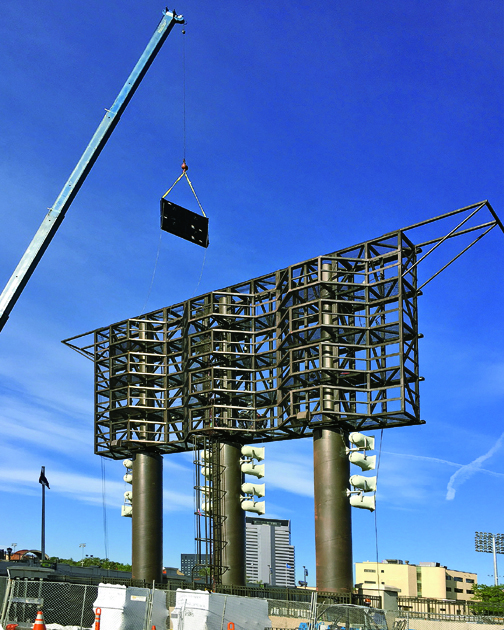 At 1,727 square feet, the new video screen installed at Infinity Park earlier this summer covers an area the size of a three bedroom house. It’s more than twice the size of the previous video board. But the gains can be measured in more ways than sheer size.
At 1,727 square feet, the new video screen installed at Infinity Park earlier this summer covers an area the size of a three bedroom house. It’s more than twice the size of the previous video board. But the gains can be measured in more ways than sheer size.
“The city planned to replace the old video screen this year,” said Linda Cassaday, Glendale’s deputy city manager. The screen had reached the end of its projected lifetime. Screen technology has not only made significant advancements in the near decade that has elapsed since Infinity Park opened, but also the old technology is truly obsolete: Cassaday said it was becoming difficult, if not impossible, to find replacement parts.
Cassaday said the new screen, and the company that made it, needed to fit a few requirements. First, the screen needed to be versatile enough to accommodate the many needs at Infinity Park, which include showing live video from rugby matches, displaying statistics and advertisements, and broadcasting movies during Monday Movie Madness (the last of which wasn’t even on the city’s radar when the first screen was installed). Second, in order to conserve time and money, the video screen needed to be able to use the old screen’s existing platform. Third, the company providing the screen needed to be able to have a proven track record of being able to respond quickly to problems when they arise. After interviewing a few companies, Cassaday said the top choice was clearly Daktronics.
Daktronics is a South Dakota-based company that has been making electronic scoreboards, programmable display systems, and large screen video displays since 1968. Both the company headquarters and the manufacturing facility are in Brookings, South Dakota, which was an important factor for Cassaday. “When you have an issue, you want to reach out locally, especially when it comes to technica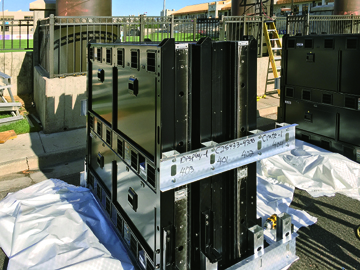 l problems,” she said. At one point, the video screen had an issue the day before a tournament. Needing a fix as soon as possible, the crew at Infinity Park was at the stadium at 1 a.m. in order to connect with the provider, which is located halfway around the world. With parts only one state away, addressing pressing issues quickly becomes much easier.
l problems,” she said. At one point, the video screen had an issue the day before a tournament. Needing a fix as soon as possible, the crew at Infinity Park was at the stadium at 1 a.m. in order to connect with the provider, which is located halfway around the world. With parts only one state away, addressing pressing issues quickly becomes much easier.
Chances are you’ve already seen a Daktronics product. Mile High Stadium, Coors Field, and Pepsi Center all use Daktronics video displays. In fact, nearly every major professional sports team in the country uses a Daktronics video screen in their home stadium, as do many college stadiums. Although this will be the first Daktronics installation at a rugby stadium in the U.S., Daktronics is no stranger to Rugby as Twickenham in London and the Adelaide Oval in Australia both use Daktronics screens.
Each board at Daktronics is custom made for the customer. The new screen at Infinity Park is the largest size that the current support system can handle. It measures 24 feet by 53 feet (the old board was 20 feet by 33 feet) and uses 13HD LED technology, the best currently available. “When you go to any sporting event and look up at the big screen, a lot of fans expect it to be as clear as their screen at home,” said Eric Cain, regional sales rep for Daktronics. “In the past, it was a bit more grainy. In the last seven years, we were able to get that clarity. That’s the goal: To make a live event realm be as good as or better than your living room.” In addition to the main video board, a new ribbon display will stretch 250 feet along the east end of the stadium.
All that new space will enhance the in-game experience for fans and will give advertisers more value for their sponsorship dollars. Instead of a static sign with a company logo printed on it, like the ones that surrounded the old video screen, the new video screen will be able to have moving logos, will be able to incorporate sponsors into in-game video, and can allow more sponsors to be featured in more interesting ways. “We can increase sponsorship opportunities because of it, recouping our cost that much more quickly,” Cassaday said. Companies can, for example, sponsor halftime or each time the home team scores. Cain said other stadiums have used the ribbon board to display statistics, freeing the main scoreboard for larger video and to engage with fans by displaying live social media feeds and conducting in-game fan polls.
The relationship between Daktronics and Infinity Park will not end when the installation is complete. Daktronics also provides software packages that display information on the screen and has in-state, full-time technicians, removing the need for Infinity Park to find contractors who are familiar enough with their video screen. Cain, who grew up in and lives in Colorado, is looking forward to a long tenure at Infinity Park. “I can’t express how pumped Daktronics is to be part of the first rugby stadium in the U.S.”

by Mark Smiley | Jun 23, 2017 | Travel
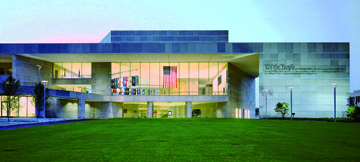 by Ruthy Wexler
by Ruthy Wexler
The U.S. Constitution is mentioned a lot these days — as a talking point. TV pundits warn that it’s being destroyed; politicians blithely assure us that a recent action they took is “in the Constitution.” If only we could go someplace and learn from scratch: what is this document that began our country?
Turns out there is such a place: the National Constitution Center.
Of course, it’s in Philadelphia — but your journey there will be shorter and less arduous than the ones delegates undertook in 1787: jouncing in carriages or on horseback, they traveled rough roads for days. Once in Philly, they sat in a sweltering hot room and argued. Why couldn’t small states have as many representatives as big ones? What sort of leader should they have, if any?
Finally they emerged with a blueprint for a free nation.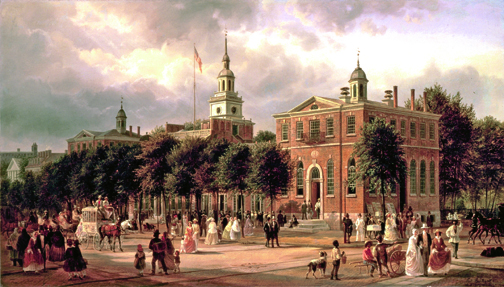
Agreed, their country wasn’t wholly free. Some delegates owned slaves, women had few rights. And no, our current society isn’t perfect. But before you withdraw into cynicism, go visit the Constitution Center. You’ll see how this complex document allowed the United States to change over the years — and how those long-ago men planned a distribution of power so skillfully, our democratic experiment is still alive.
Freedom Rising
Best to start a few blocks away where the Constitution was written: Independence Hall, which looks exactly the way it did 230 years ago. A guide points out the dais where George Washington sat and watched each day’s proceedings without ever saying a word. (Everyone knew how much he cared.)
Approaching the Constitution Center, a shining white structure set way back on a wide lawn, I’m stirred to wonder: how did the Founding Fathers come to design a country around the idea of freedom?
The introductory multimedia presentation, Freedom Rising, explains. Colonists knew they needed a central government for safety — but feared giving any foothold to tyranny, the thing they hated most. So their representatives, framing the new government’s basis, analyzed each sentence and statue: would it allow liberty to survive?
“Can liberty survive?” the narrator concludes dramatically. “It depends on you … and you … and you.”
Rich History
The Story of We the People, the ring-shaped series of exhibits on the second floor, constitutes the heart of the museum. One of the first displays is a shelf of Enlightenment books that delegates referenced while deliberating. We learn that Thomas Jefferson shipped volumes from France so James Madison could study ancient federations. Whatever their limitations, the framers were not, as some have claimed, interested only in protecting their property.
With timelines etched above, explanations at eye level and details crammed in every corner, history comes alive. Exhibits, arranged in chronological order, show how the Constitution was challenged and survived. There are exhibits for each of the original seven articles, for the Bill of Rights (the first 10 amendments) and the other amendments as well. Because they’re connected to constitutional issues, we learn about slavery, freedom of speech, labor unions and capital punishment.
Forward March Of Justice
It’s not just gazing into glass cases. You can pull levers in a voting booth, take the presidential oath at a podium, watch a video of new U.S. citizens. Winding my way around the rotunda, I see, at intervals, the same interactive screen: Can You Vote? Early on, the screen asks, “Are you white?” I press “yes” and am allowed to continue. But when I say no to the next question, “Are you a man?” a big red DENIED lets me go no further.
Even though I knew it was coming, I feel the unfairness.
Subsequent screens show how fairness got slowly instituted: nonwhites able to vote after the Civil War), then women (19th Amendment), then 18-year-olds (26th amendment. The framers, men of their time, were wise enough to know that times change; to ensure liberty for unknown future generations, they put the amendment process in place.
Exhibits show how the Constitution stretched for justice to march forward. Sometimes, as demonstrated in the Dred Scott exhibit, freedom took a backward step, when judges were slaves to beliefs of their time and could only interpret the Constitution narrowly.
It’s a document to be proud of, but not complacent about. More deeply than ever before, I’m seeing that if liberty is to survive, it is truly up to “you … and you …” and me.
The last exhibit is delightful Signers Hall, where 42 life-size figures — the 39 who signed the Constitution and the three who refused — stand frozen in thoughtful poses. I see how tall Washington was, and that Alexander Hamilton, of recent Broadway fame, was quite short!
As everyone snaps selfies with the signers, a docent offers personal tidbits; e.g., Rufus King of Massachusetts borrowed books from the library but never returned them; Washington went fishing during the August recess and caught some perch. And when the Constitution came back from being engrossed on parchment, it was, Washington said, “little short of a miracle.”
After all, this was the first time that a people had written down rules to start a nation off from scratch.
Historic Philadelphia
The National Constitution Center welcomes visitors seven days a week (except major holidays). Children enter free; tickets (adults, $14.50; seniors, $13) are half p rice if you go first to the Visitors Center, get tickets to Independence Hall and present those passes. Another advantage to stopping at the Visitors Center: the roving Once Upon A Nation storytellers who will spin a true yarn while you rest on a bench.
rice if you go first to the Visitors Center, get tickets to Independence Hall and present those passes. Another advantage to stopping at the Visitors Center: the roving Once Upon A Nation storytellers who will spin a true yarn while you rest on a bench.
The Constitution Center frequently hosts presentations, “timely constitutional conversations from all sides of the debate” and your trip could possibly be planned around one of these enlightening town halls. To find out more, visit constitutioncenter.org or call 215-409-6600. To see more pictures, visit www.glendalecherrycreek.com.

 The Glendale Sports Center is best known for its sports, fitness, and teen programs. Many are unaware it offers music lessons as well. The arts and humanities division of the Glendale Sports Center currently offers private piano, drum, and guitar lessons. Lessons are $36 each hour and sold in groups of four.
The Glendale Sports Center is best known for its sports, fitness, and teen programs. Many are unaware it offers music lessons as well. The arts and humanities division of the Glendale Sports Center currently offers private piano, drum, and guitar lessons. Lessons are $36 each hour and sold in groups of four.








